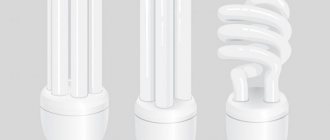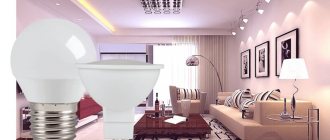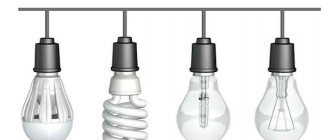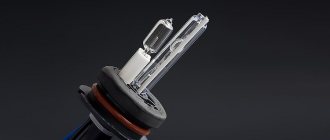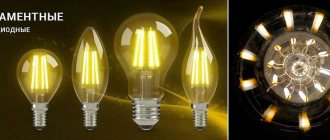– Is it true that LED lamps consume less electricity?
- Absolutely. If we compare with energy-saving fluorescent lamps, the light output of LEDs with the same energy consumption is 1.5-2 times higher. Incandescent lamps consume 8 times more electrical energy, providing the same brightness of light. But saving is not only about this. Operating costs when using LEDs are reduced several times also due to the much longer service life that these lighting devices are characterized by. If, for example, you screw in an incandescent light bulb in the entrance and leave it on for 12 hours a day, then about 6 of them will have to be replaced in a year. In the case of an energy-saving lamp, you only need to replace it once a year. But the same LED lamp under the same operating conditions will last 10 years.
Main conclusions
It is possible to answer the question whether LED lamps are harmful or not only after a thorough study of their design and basic principles of operation.
- The design of LED lamps does not involve the use of hazardous chemicals and substances.
- High-quality products cannot be cheap due to the features of their device.
- When purchasing a lamp, you need to pay attention to the color temperature of the product, thereby minimizing harm to the eyes when using it.
- In the evening, it is better not to use LED lighting, as it negatively affects melatonin production.
- IR and UV radiation emitted by the devices is extremely small and harmless to humans.
LED lamps are not only extremely efficient for domestic use, but also safe and environmentally friendly. Especially in comparison with mercury energy-saving analogues and incandescent lamps.
Previous
LEDsHow to check the performance of a diode with a multimeter
Next
Lamps and fixtures How to properly connect an LED to a 220 V network
– Is LED lighting harmful to humans?
– From time to time, articles appear on the Internet with arguments against LEDs. They say the light they produce is harmful to the eyes. It is impossible to say unequivocally that this is completely untrue. But the point is not in the LEDs, but in the color temperature of the light flux they emit. It is measured in kelvins (K) and is indicated on the packaging of the lighting fixture. The higher the color temperature, the cooler white light the device produces.
If during the day in the office, when mixing artificial and natural lighting (with high color temperatures of 5000-6000 K), this is acceptable, then home and night lighting should be made warmer. In other words, artificial “daylight” light is good during the day, but in the evening it should have a more yellow, soft tint, then there will be no harm to health.
For children's rooms, experts recommend purchasing LED lamps with a color temperature above 3000–4000 K. By replacing halogen and fluorescent lamps with LED lamps, but with the right color temperature, you will get better quality light that does not pulsate, perfectly conveys shades, and has a higher contrast . It has been proven that LED lighting promotes long-term performance.
The impact of LED lighting on human health
Recently, several governments have announced the publication of rigorous research into the health effects of solid-state lighting (SSL). This review examines whether energy-efficient LED systems are safe for lighting our homes, buildings and outdoor areas. The authors concluded that SSL technology has no greater direct negative impacts on human health than other lighting technologies. As for the impact on humans of electromagnetic fields emitted by LED lamps, their magnitude is usually much less than in the case of gas-discharge lamps and some household appliances. The report also makes recommendations regarding flicker and glare.
The International Energy Agency (IEA) was created to help member governments promote SSL as an effective means to reduce energy consumption worldwide. Beginning in 2011, the IEA launched a review of the primary medical literature related to LED lighting. The purpose of this paper was to provide a literature review for policymakers on whether SSL products are less secure than the products they intend to replace.
The study assessed electrical hazards, exposure to electromagnetic fields, glare, photobiological hazards, flicker and non-visible light effects. A detailed overview of these topic areas is provided, which provides decision makers with information about the possibility of using LED lighting in various areas of human activity.
Electrical safety
The report concluded that it is advisable to solve the electrical safety of SSL products through compliance with existing international electrical safety standards, since electrical safety is mainly ensured by the design of the luminaire and the power source (converter).
Electromagnetic compatibility
Experts have concluded that human exposure to electromagnetic radiation from SSL products is negligible because the magnitude is generally much lower than that from discharge lamps and some household appliances.
Danger to eyesight
Glare should be recognized as an important issue in assessing the security of SSL products. The study recommends that products of significant brightness be specified whether products are point light sources or not, as such light sources may cause eye damage. The luminance ratio of the light source and the background must be calculated and adapted to each lighting installation in accordance with visual ergonomic criteria.
Photobiological effects
In the area of photobiological exposure, the report notes that a safety assessment should be carried out for all SSL devices in accordance with CIE S009/IEC 62471, and in accordance with the guidance of IEC TR 62778. Manufacturers of LEDs and LED devices should indicate the risk group of the product.
Flicker of light
Regarding light flickering, modulation of the luminous flux of a light source, it is indicated that these effects can cause discomfort or worse, cause seizures in patients who suffer from photosensitive epilepsy. Some LED bulbs are flicker-free, while other devices reach maximum flicker levels. It is recommended to set a limit on the maximum flicker value that is mandatory for manufacturers of SSL products to comply with.
Spectral composition
Finally, the invisible effects of light were studied, which is also important for all other light sources and must be taken into account when designing and using lighting systems. LEDs are very flexible devices in terms of their emission spectrum. As a result, LED devices are currently used by doctors to treat certain pathologies, in phototherapy, which uses the effects of light of different spectral composition. And in the future, as the influence of the spectral composition of radiation on humans is studied, it may lead to an expansion of the use of phototherapy for the treatment of certain diseases.
Compared to other lighting technologies, SSL technology is not expected to have a greater negative impact on human health than other light sources. However, SSL technology is indirectly responsible for the overall increase in illumination, so it is recommended to maintain a balance of ambient lighting at night while maintaining acceptable levels of exposure during the day through a combination of daylight and artificial lighting.
Through the 2013 report and other work, the IEA (SSL Annex) is working to support international efforts at the national and regional level by addressing key SSL technology issues. Countries participating in the SSL Annex believe that there are significant advantages in achieving consensus in international cooperation on harmonizing approaches to SSL production and quality. Sponsoring governments of SSL Annex countries include: Australia, Denmark, France, Japan, Korea, Netherlands, Sweden, United Kingdom and United States. China also participates as an expert member of the SSL Annex. The work of the SSL Annex covers a wide range of initiatives that can be found on the organization's website (at https://ssl.iea-4e.org/), including guidance for policymakers, guidance for assessing quality and performance levels, and support for laboratory accreditation.
Literature: Led Professional - Trends & Technologies for Future Lighting Solutions, Oct 08, 2014
Back to news list
– Why are LEDs considered safe devices?
– An incandescent lamp can be broken, accidentally crushed and cut. The LED lamp does not contain glass, fragile components; it is quite difficult to damage it accidentally. Traditional energy-saving lamps contain substances inside the structure that are harmful to the environment and human health, so they should be handled with care so as not to damage their integrity. They have to be disposed of in a special way. LEDs are made without the use of mercury or gases. After failure, they can simply be thrown away, which greatly simplifies the use of these lighting devices.
– Do LED lamps flicker?
– Look at the light of such a lamp through a digital camera. If the LED lamp is equipped with a high-quality driver, then you will not see moving stripes or flickering. Fluorescent lamps, on the contrary, emit pulsating light, which is recognized as harmful to the human visual system and to his health in general. After a long stay in a room with fluorescent lighting, headaches, fatigue, and inability to concentrate may appear. If there are LEDs in the room, this is impossible.
Features of work
Flicker of light
Why do LED lamps pulsate? The reason is the frequency of the electric current, which is measured in hertz (Hz). So in the network it is variable, and in order to avoid ripple, it needs to be converted to constant. For this purpose, LED lamps are equipped with drivers.
The flickering of the light depends on the quality of the driver. The good ones keep ripple to a minimum, which is much better than incandescent or fluorescent lamps. Bad drivers (Chinese light bulbs are most often equipped with them) do not convert alternating current to direct current, but release a lot of direct current charges, which causes the light bulb to flicker.
Conclusion: High-quality LED bulbs do not pulsate and are no more dangerous than incandescent bulbs. Choose models with a pulsation of less than 20% - and you will not feel any negative impact.
A small life hack that will allow you to check whether an LED lamp is flickering. Point your phone camera at her. If you see stripes on the screen, the pulsation is strong enough to cause discomfort.
Blue spectrum
Blue light has been shown to reduce melatonin production. In addition, fatigue increases, the eyes become more strained, and therefore vision deteriorates. A recent study by Spanish scientists proved that exposure to LED lighting increases the number of dead retinal epithelial cells.
Does this mean LEDs are harmful? Yes and no. Firstly, if you use light bulbs with a warm or neutral color temperature, then the negative influence of the blue spectrum will be less. Secondly, cool white lamps also have significant benefits - for example, they help to concentrate. It is advisable to spend less time in rooms with cold white light and exclude it for 2-3 hours before bedtime.
According to the classification of light sources according to the EN 62471 standard, there are four hazard groups, from 0 to 3. LEDs belong to group 2, but can go into group 1 if lensed LEDs or low-power diodes are used.
